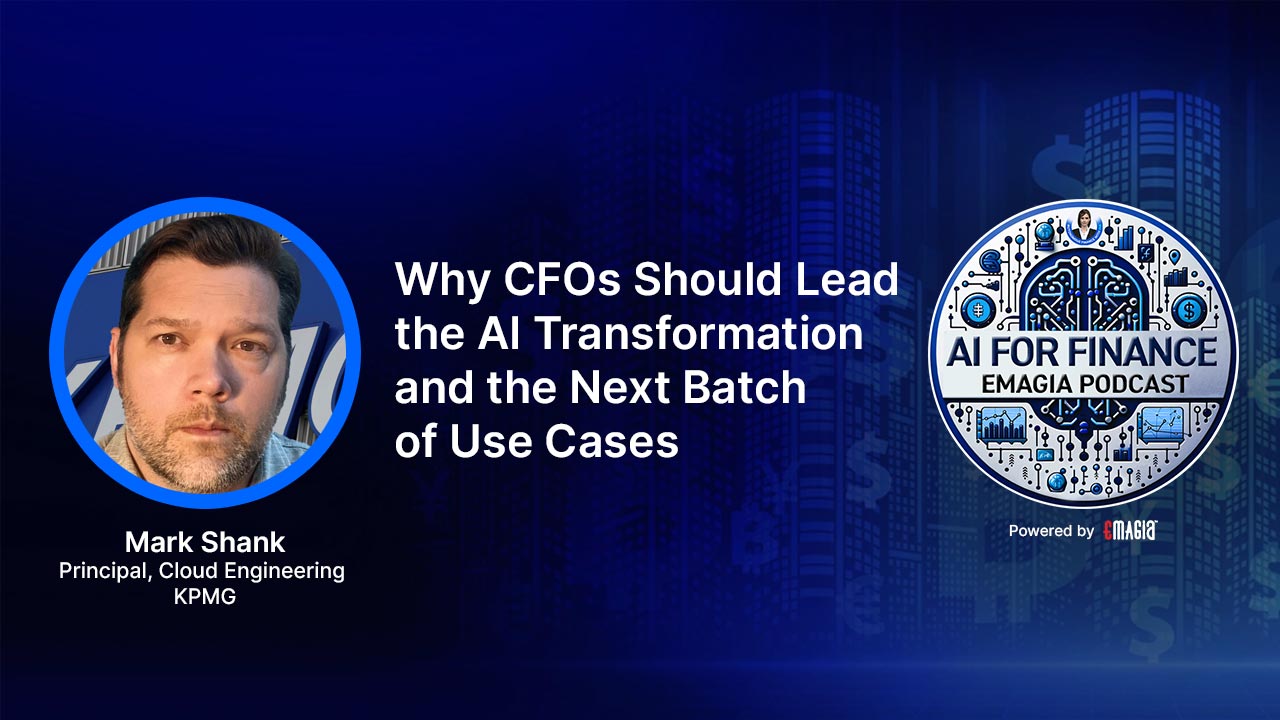The Road to AI-Driven Efficiency
Generative AI can significantly reduce time spent on routine tasks, allowing employees to focus on higher-level work. By automating processes like data entry and initial email drafts, AI enables employees to become reviewers and decision-makers rather than simply task executors.
- Identifying key accounts
- Flagging accounts for follow-up
- Drafting customer emails
Generative AI has evolved significantly since Mark Shank’s early days at KPMG, where it was used for predictive analytics in sectors like telecommunications and sports scheduling. Today, AI’s influence in business transformation is undeniable, and companies like KPMG have made substantial investments to harness its potential.
Shank, principal of cloud engineering at KPMG, recently shared insights on the Emagia AI for Finance podcast, where he spoke on, among other things, why CFOs should take the lead in AI transformations within their organizations.
AI’s Game-Changing Moment
In AI’s earliest days, only the largest organizations could afford specialized models for risk and fraud detection. However, with the advent of accessible tools like ChatGPT, companies of all sizes can now leverage AI.
“Now, a general-purpose model trained on vast amounts of data is in the hands of employees,” Shank explained. “It’s an out-of-the-box model that can do interesting things from day one.”
AI is quickly becoming integral to forward-thinking business operations, but a key challenge remains: integrating a company’s unique data with AI tools to create context-aware solutions. Shank described this as the “next batch of use cases”—bringing internal data to AI to unlock new levels of automation previously limited by high investment costs.
AI as a Tool for Efficiency
One of AI’s most transformative benefits is its ability to shift employees from time-consuming tasks, like manually drafting emails and data entry, to more value-added activities. Shank envisions a future where AI enables employees to become “editors rather than writers.” For instance, generative AI can identify key accounts, flag accounts for follow-up, and draft emails, leaving employees to review and send. This automation can save significant time and streamline operations.
The CFO’s Role in AI Transformation
For CFOs, leading AI initiatives is crucial. They must assess how AI can improve productivity and decision-making, balancing costs with the potential for quality and efficiency gains. Shank noted that AI’s role will only grow, making it essential for CFOs to champion AI strategies that align with financial goals and equip employees with powerful, productivity-enhancing tools.
Shank urged CFOs to consider the risks of delayed AI adoption. As AI capabilities continue to expand exponentially, companies that do not keep pace may find themselves at a competitive disadvantage. Citing OpenAI’s Sam Altman, Shank emphasized the rapid growth trajectory AI is on.
“If your organization hasn’t adopted this technology, you could miss out on game-changing improvements that competitors are already embracing,” he said.
Renewed Interest in AI Innovation
AI has seen periods of slowed progress, often referred to as “AI winters,” during which funding and interest decline. Shank noted similar slowdowns in the 1980s and ‘90s but highlighted the recent flood of capital into AI startups, signaling a new era of innovation.
“Capital markets are pouring money into AI,” Shank said, though he cautions companies to temper their expectations. AI adoption should focus on achievable goals that deliver clear business value.
FAQs
What is an “AI Winter?”
“AI winter” refers to periods in AI’s history where investment and enthusiasm have declined. These lulls, often triggered by unmet expectations, lead to reduced funding and interest in AI research. The release of ChatGPT in 2022 helped end the most recent AI winter, sparking a renewed wave of AI innovation and investment.
What is ChatGPT?
Developed by OpenAI, ChatGPT is a generative AI model that launched in late 2022 and quickly gained popularity for its conversational capabilities. It uses large language models (LLMs) to interact with users, answer questions, and generate creative content. In 2024, it was announced that ChatGPT will be integrated into Apple’s operating systems.









